
I don’t usually write about equipment. Mostly because I get two or three sentences and I’ve said all I have to say, or because I fall asleep typing, fall forward and hit my nose on my desk. Nothing shouts excitement like a new shell holder or pair of pliers, but the search for a useful, reasonably priced borescope has been long and fraught with peril, so it seemed worth mentioning.
My first choice for a borescope would be a Hawkeye unit from Gradient Lens. Through the eye piece the image is bright, contrast and color are excellent and these scopes have good light sources that enhance, rather than detract from the image. At 17″, the basic unit cost is approximately $745, a 22″ unit $1,295. If I want to view the image on a portable monitor, not a computer or tablet monitor, there is an added cost of a proprietary camera $1,095 and a hand held monitor another $1,095. If I want to record video or import into a computer, I would need to add optional USB capture device at $435.
So for $3370 to $3920 I could bore check a firearm and have a record for monitoring bore condition over the life of a firearm. The Hawkeye is the lowest grade optical device they produce, an objective lens ahead of a relay lenses that lead to an eyepiece. More costly and precision units use a higher grade objective lens, multiple series of relay lenses, indexed, color and aberration corrected where critical imagery is required. Those prices start where the prior package leaves off and then requires all of the camera gear as an additional cost to accomplish the same.
For my purposes, a unit like the one I just described represents an excessive and unnecessary expense and there is something about an expensive product that touts compatibility with “Windows 2000, ME, XP, or VISTA and requires at least a Pentium IV 1 GHz or Faster Processor” that screams obsolescence or lack of producing company interest.
You can’t get there from here…
There are many inexpensive digital borescopes on the market. The unit above has a tiny 3.9mm CMOS camera at the end of a flexible shaft and an impressive array of features; memory, video, still image, light control, easy transfer to a computer, etc. The cost was $119 and this unit is sold in a number of colors, under many brands. Unfortunately, what is missing in image quality.
Unlike a fiber optic scope where there is an objective lens on the end, passing an image up a long relay lens or lenses to a magnifying eyepiece, this type of unit has a small CMOS camera at the end of the probe that sends a digital image back up the length of the probe, then displays the image on a small LCD monitor or stores it in a memory device. The quality of the image is limited to the quality of the camera, the quality of the displaying monitor and the amount and control of light placed at the camera end.
The type of camera typically found in these inexpensive digital borescopes is based upon a 1/18 inch color CMOS chip that produced 240 TV lines, works down to 2.0 lux, has a 55° field of view and measures less than 0.18 in diameter; a low resolution image with limited low light capability. The camera cost is a few dollars. By comparison, a quality camera found in more critical application, medical, aircraft inspection, etc. costs approximately $2,600. You do get what you pay for.
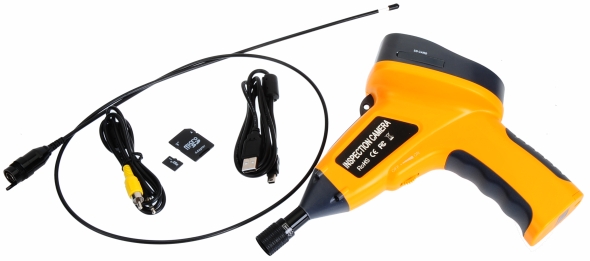
In this small 3.9mm diameter camera, there is no 90° mirror accessory, so the image perspective is right down the barrel and it is not very sharp. Additionally, the low LED light output puts a blue cast on the image and it is nearly impossible to discern colors to differentiate between steel, copper and lead deposits. I am sure one day the quality will be there, but not now. And, yes, I’ve tried about a dozen, some in the $1,200 price range; universally focus is soft and a blue/purple cast washes away the colors on the material being examined.
Lyman’s digital borescope…
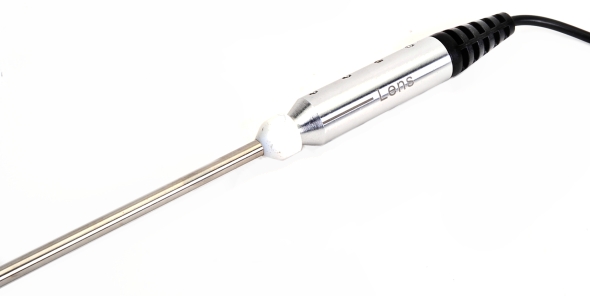
The Lyman unit borrows from both optical probe and camera approaches. In place of an expensive focusing eyepiece, independent light source, CCD camera, and USB converter is an inexpensive CMOS camera that captures the image transmitted up the fiber optic probe and passes it to an inexpensive LCD display. Additionally, an inexpensive LED light source inside the camera housing transmits light down the probe through the sheathing that resides between the probe’s outer metal housing and its central fiber optic and illuminates the subject.
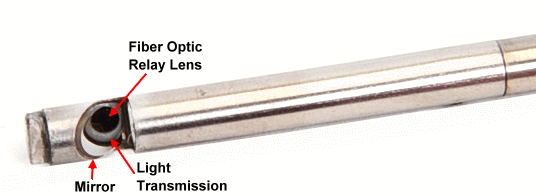
Missing at the tip of the probe is the costly two element objective lens. Seen in the reflective surface of the 45° angle mirror is the fiber optic component that transmits the image the length of the probe and the sheathing that transmits light to the subject. The mirror allows close inspection of a firearm’s bore and chamber walls, rather than a head on look that does not show surfaces clearly.
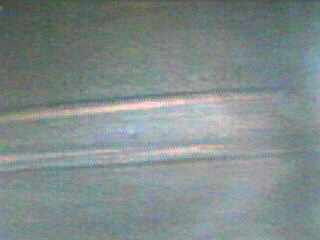
The result is the quality is pictured left. Is it the quality of a Hawkeye Borescope? Of course not, but then we are comparing a couple hundred dollars to a few thousand for the same feature capability. Is the image as poor at the miniature camera borescope? Certainly not.
This image is good enough to see bore leading or leade erosion and it actually has better sharpness and contrast when viewed directly on the borescope’s monitor. I do not know the resolution of the monitor. The photo resolution the unit produces is 320×240.
The probe is 20″ long and will fit anything .20 caliber and larger. Longer barrels are accommodated by poking down from the muzzle and then from the breech end. While the Lyman Borecam does not have video recording capability, it is quite easy to map the bore of any given rifle for future monitoring.

The probe is scaled in 1/8″ and 1″ increments. I ran the probe and took photos as needed, labeling the photos and noting the position of any key locations “3 5/8″ @ 9 o’clock”. All of the information was moved to a computer and logged as an all inclusive Word document.
Easy to use…
A simple menu system controls power, brightness of probe lighting, preview or live view and some very basic setup steps. The monitor is central to function.
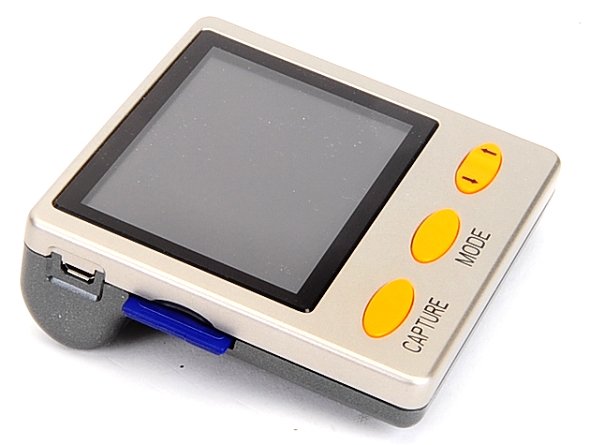
The probe’s Micro USB connector plugs into the left side, a 5v power supply plugs into the right side. The power supply works with line voltages of 100v to 240v, five receptacle adapters are included to permit use outside of the U.S.. The on/off switch is on the back of the monitor. The power supply connection to the 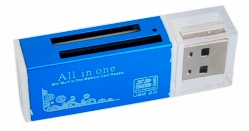 monitor is a USB type on both ends; standard on the end that goes into the power plug, Micro USB on the other. During the product assessment, rather than plug into an electrical outlet, I plugged the standard USB cord end into a powered USB port on a lap top, 5v, and the unit worked and powered the probe.
monitor is a USB type on both ends; standard on the end that goes into the power plug, Micro USB on the other. During the product assessment, rather than plug into an electrical outlet, I plugged the standard USB cord end into a powered USB port on a lap top, 5v, and the unit worked and powered the probe.
A 128 MB SD card is included with the unit. The Borecam can be used without the SD card, however, images cannot be stored in its absence. Stored images on the SD card can be played back on the unit’s monitor or files can be transferred from the SD card to a computer. A card adapter is included with the borescope which permits image transfer from card to computer through any standard USB port. My computer is set up with Nikon software to transfer images from cameras and other devices for editing and incorporation into articles. The same software recognized the presence of the SD card and transferred all images routinely.
Value
The Lyman Borecam is well made and suitable for the intended use environment. No, it is not chemical, water and oil proof, but reasonable care as would be afforded any decent equipment is good enough. Controls are positive, navigation is simple, use is rewarding. Lower cost CMOS camera probe types do not compare and in most cases really won’t get the job done. Higher priced precision optical borescopes present a significantly better image, but they are well outside the budgetary criteria for many, if not most and they tax even small business budgets.
It is important to shop before buying. In most places this is a $259 plus shipping purchase. I purchased the subject Borecam from Optics Planet for $195 and with free shipping. For me, this is the first non-precision borescope I would consider as being able to get the job done. It adds capability to the shop and it is so easy to use it will be used a great deal.

Email Notification